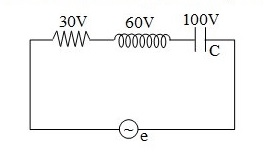
In the given figure, the potential difference is shown on \[R\], \[L\] and \[C\]. The emf of source in volt is
A) \[190\]
B) \[70\]
C) \[50\]
D)\[40\]

Answer
218.4k+ views
Hint: In this question, the given circuit is RLC and AC source is applied, so the concept of the resultant voltage concept will be used that is induction voltage and the capacitance voltage are at same phase while the resistance voltage are at perpendicular phase.
Complete step by step answer:
A standard RLC circuit consists of a resistor, an inductor and a capacitor in series. We consider the voltage across the resistor \[{V_R}\], the voltage across the inductor \[{V_L}\], and the voltage across the capacitor to be \[{V_c}\].
Now this type of circuit has a specific frequency at which it resonates. That is called the resonating frequency.
So, the standard formula to be used in simple series RLC circuit is-
\[ \Rightarrow {V_e} = \sqrt {V_R^2 + {{\left( {{V_L} - {V_C}} \right)}^2}} \]
From the given circuit, we have ${V_R}$ is $30\;{\text{V}}$, ${V_L}$ is $60\;{\text{V}}$, and ${V_C}$ is $100\;{\text{V}}$. Now, we substitute the given values in the above equation as,
\[ \Rightarrow {V_e} = \sqrt {{{30}^2} + {{\left( {60 - 100} \right)}^2}} \]
Now, we simplify the above equation as,
\[ \Rightarrow {V_e} = \sqrt {{{30}^2} + {{\left( { - 40} \right)}^2}} \]
After calculation we get the result as,
\[\therefore V = 50V\]
Hence, the voltage from the emf source obtained across the series combination of the given RLC circuit is \[50V\].
Thus, the correct option is C.
Note: We have seen that the three basic components in a circuit are Resistance, Inductance, and Capacitance have very different phase relationships to each other when connected to a sinusoidal alternating supply which in this case is the source of the emf given. The negative sign in the formula of the net voltage indicates that the inductor is ahead of the capacitance by some degrees phase angle. If the circuit is completely a resistor circuit then the difference in voltages of the other two would have been zero. The resistance of an inductor is \[L\omega \], and that of capacitor is \[\dfrac{1}{{C\omega }}\], where \[C\] is the capacitance and \[L\] is the inductance provided.
Complete step by step answer:
A standard RLC circuit consists of a resistor, an inductor and a capacitor in series. We consider the voltage across the resistor \[{V_R}\], the voltage across the inductor \[{V_L}\], and the voltage across the capacitor to be \[{V_c}\].
Now this type of circuit has a specific frequency at which it resonates. That is called the resonating frequency.
So, the standard formula to be used in simple series RLC circuit is-
\[ \Rightarrow {V_e} = \sqrt {V_R^2 + {{\left( {{V_L} - {V_C}} \right)}^2}} \]
From the given circuit, we have ${V_R}$ is $30\;{\text{V}}$, ${V_L}$ is $60\;{\text{V}}$, and ${V_C}$ is $100\;{\text{V}}$. Now, we substitute the given values in the above equation as,
\[ \Rightarrow {V_e} = \sqrt {{{30}^2} + {{\left( {60 - 100} \right)}^2}} \]
Now, we simplify the above equation as,
\[ \Rightarrow {V_e} = \sqrt {{{30}^2} + {{\left( { - 40} \right)}^2}} \]
After calculation we get the result as,
\[\therefore V = 50V\]
Hence, the voltage from the emf source obtained across the series combination of the given RLC circuit is \[50V\].
Thus, the correct option is C.
Note: We have seen that the three basic components in a circuit are Resistance, Inductance, and Capacitance have very different phase relationships to each other when connected to a sinusoidal alternating supply which in this case is the source of the emf given. The negative sign in the formula of the net voltage indicates that the inductor is ahead of the capacitance by some degrees phase angle. If the circuit is completely a resistor circuit then the difference in voltages of the other two would have been zero. The resistance of an inductor is \[L\omega \], and that of capacitor is \[\dfrac{1}{{C\omega }}\], where \[C\] is the capacitance and \[L\] is the inductance provided.
Recently Updated Pages
A square frame of side 10 cm and a long straight wire class 12 physics JEE_Main

The work done in slowly moving an electron of charge class 12 physics JEE_Main

Two identical charged spheres suspended from a common class 12 physics JEE_Main

According to Bohrs theory the timeaveraged magnetic class 12 physics JEE_Main

ill in the blanks Pure tungsten has A Low resistivity class 12 physics JEE_Main

The value of the resistor RS needed in the DC voltage class 12 physics JEE_Main

Trending doubts
JEE Main 2026: Application Form Open, Exam Dates, Syllabus, Eligibility & Question Papers

Derivation of Equation of Trajectory Explained for Students

Hybridisation in Chemistry – Concept, Types & Applications

Understanding the Angle of Deviation in a Prism

Understanding Collisions: Types and Examples for Students

Understanding Atomic Structure for Beginners

Other Pages
JEE Advanced Marks vs Ranks 2025: Understanding Category-wise Qualifying Marks and Previous Year Cut-offs

How to Convert a Galvanometer into an Ammeter or Voltmeter

Understanding Centrifugal Force in Physics

Ideal and Non-Ideal Solutions Explained for Class 12 Chemistry

Degree of Dissociation: Meaning, Formula, Calculation & Uses

Understanding Electromagnetic Waves and Their Importance




